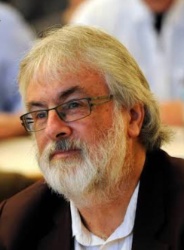"Musul Bombalanyor" and "The City That Knows How"
"Musul Bombalanyor" and "The City That Knows How"
By Rosalea Barker
Communications satellites have taken the moving image full circle back to being a silent film. On Saturday, as I had lunch in San Francisco, the Turkish channel NTV was playing on a big monitor up in the corner of the restaurant. Last time I was there, a month or so ago, the programme was one of those shows where a reporter is sent out to find the long-lost loved ones of a viewer so they can (or maybe not) be reunited on air. Nowadays NTV has 24-hour coverage of the war in Iraq.
It was midnight there, if the clock in the top left-hand corner was showing Iraq time, so they were using night-vision cameras, which turn the whole world an almost Islamic green. By "they" I mean whichever news service NTV was getting its coverage of the bombardment of Mosul from. The station would cut back to the studio every now and then, and occasionally throw to a couple of reporters in the field somewhere. One time when I looked up, the station was showing film of the treatment Iraqi prisoners of war were getting from their captors. (I'm assuming, because of the desert landscape, that it was in Southern Iraq and that these soldiers had surrendered willingly.)
I don't recall seeing the faces of any of them. There was a close-up shot of a prisoner's bare feet as he sat cross-legged in the sand. Another prisoner had a nice clean elastic bandage around his ankle, somewhat too loosely tied, I thought, to have any effect if he'd sprained it. As there was not a callus or a corn or a blister to be seen on those two men's feet, I recommend that one of the first things the US Army does when it's in control of the country is contract out its bootmaking to whoever makes them for the Iraqis.
Then there was a shot of a prisoner's hands foldly quietly, and unrestrained, in his lap. A wide shot showed a US soldier dipping a cup into a water barrel and pouring some of it into the captives' plastic water containers. Another shot showed, from a respectful distance, the prisoners performing their prayer ritual within a square of tidy tents. Now, even if the sound had been turned up, I wouldn't have understood it since it was in Turkish, but neither would anyone watching it in Northern Iraq. I guess Turkey has given the US permission to use more than one airspace.
Mosul, which is where the live night-time pictures were coming from, is relatively near the Turkish border and the oil pipeline that goes from Iraq through Turkey. There were reports from other spots too, and one of the names in the graphics I was to recognise much later in the day as I listened to the BBC World News on the radio. Someone was explaining to the BBC as carefully as if they were tiptoeing around a minefield that the electricity to that city had been "mysteriously" cut, pipes had been damaged, and the water pumping station no longer worked
My only knowledge of what's being shown on television here in the US comes from glimpses in settings where there is a television, media commentary in the papers, and people's comments - such as the Turkish restaurant proprietor saying that NTV has full-time coverage of the war, "not like here, where it is little bit, little bit," as he makes a chopping motion with his hand.
You have to wonder if the timing of Operation Iraqi Fiefdom has anything to do with what happened back in 1970 when Nixon bombed Cambodia and university campuses across the US burst into violent - and deadly - protest. That was in May, at the time of final exams. Last week for some campuses, and this week for others, is spring break - a time when students traditionally go home or to the mountains or the beach for fun and relaxation after mid-term exams. The reality show people are even filming a spring break movie down in Mexico at this time.
The big television event for spring break is the college basketball playoffs, and apparently those are still being aired on CBS. It's a great way of showing the patriotism of the nation's young people, I suppose, as they no doubt sing the national anthem before every game and salute the flag and honour their age-sakes in the forces. I don't really get the argument that we should have live coverage 24 hours a day of the war - but then I never watched cop programmes on television either, because I don't think that's entertainment. There's a point at which the news value of constant television coverage of a war decreases so much, it becomes just a spectacle.
Well. I didn't mean to write so much about the media. The reason I was in San Francisco on Saturday was to go to the rally at the civic centre, which I did with some trepidation. Someone I know who'd been to all the marches shared that trepidation to the extent that she stayed home. What worried both of us were the 2,000 arrests that have taken place in San Francisco in the past couple of days as protesters closed down intersections, invaded the Federal Building, and so on. The signs on lamp-posts said it was a rally - no mention of a march - so I thought I'd chance it, just to see who else would.
To my astonishment, tens of thousands of the same ordinary people who went to the earlier rallies were at this one - mums and dads with their kids, elderly churchgoers - along with the usual small proportion of hardcore protesters. And march we did, even though none was scheduled. What an amazing thing to witness - the encircling, in good humour, of a whole city center, as the march didn't just go up Market Street to the rally, as the other ones had. It went *from* the rally, down Market Street, returning up Mission Street, the two halves of the march cheering at every cross street down which they could see each other.
The orderly march was possible, of course, only because the SFPD was prepared for it to happen and had a mobile command centre in a converted municipal bus, from which they dispatched traffic officers and police cars to intersections where traffic needed to be diverted, as reports came in from their helicopter. I thought it was just a bus that had been stranded by the march, and took a photo of it and the back view of the marchers setting out from city hall, because of the irony of its destination sign: "San Francisco - The city that knows how".
It will be the city that knows bankruptcy before too long, if the protests keep going any longer, forcing long hours and overtime payments for the police, parking and transportation, and other city workers. But it seems the protest movement knows that, and will be moving its civil disobedience actions to other targets next week. Lord knows, the trickle-down effect of cuts to federal spending so the war can be paid for has already dealt state and local body coffers a severe body blow. It would be too bad if some "bombalanyor" in a foreign country ends up cutting off San Francisco's electricity and water as well.
In the meantime, if the mayor would like to
commend somebody for their work, I nominate the grey-haired
man whose only sign of authority was his fluoro pink
Parking and Transportation vest - who looked weary when I
first saw him and even wearier two hours later. Quietly and
authoratively he asked protestors who were blocking one
intersection on Market near Van Ness (which is also a main
highway) to move aside so some cars trapped in the march
could detour out of it. Cheerfully, the protestors obliged.


 Martin LeFevre - Meditations: In A Global Society, There Is No Such Thing As “National Security”
Martin LeFevre - Meditations: In A Global Society, There Is No Such Thing As “National Security” Binoy Kampmark: Secrecy And Virtue Signalling - Another View Of Signalgate
Binoy Kampmark: Secrecy And Virtue Signalling - Another View Of Signalgate Gordon Campbell: On The Americanising Of NZ’s Public Health System
Gordon Campbell: On The Americanising Of NZ’s Public Health System Ian Powell: Trumpian Health Leadership
Ian Powell: Trumpian Health Leadership Eugene Doyle: Disruption - Historians Challenge Russophobic Propaganda
Eugene Doyle: Disruption - Historians Challenge Russophobic Propaganda Ramzy Baroud: War, Doublethink, And The Struggle For Survival - Geopolitics Of The Gaza Genocide
Ramzy Baroud: War, Doublethink, And The Struggle For Survival - Geopolitics Of The Gaza Genocide